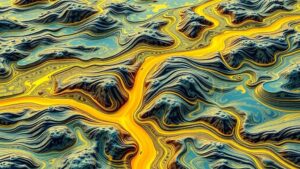Using Stream Flow Models to Predict Gold Deposition Areas
Using Stream Flow Models to Predict Gold Deposition Areas
The quest for gold has driven exploration and extraction for centuries, leading to significant advancements in geology and resource management. One of the latest techniques in gold prospecting involves using stream flow models to identify potential areas for gold deposition. This article delves into how these models function, their application in mineral exploration, and the implications for sustainable mining practices.
Understanding Stream Flow Models
Stream flow models are mathematical representations of how water moves through river systems. e models consider variables such as precipitation, topography, soil types, and land use. By simulating how water flows, these models can provide vital insights into sediment transport and deposition patterns.
For gold deposition, stream flow models help predict where gold particles may accumulate due to hydrodynamic forces in a river. As gold is a dense metal, it typically settles in specific areas known as pay streaks, which are influenced by stream flow dynamics.
The Process of Modeling Stream Flow
The development of a stream flow model typically follows several steps:
- Data Collection: Gathering data on watershed characteristics, including rainfall, land cover, soil types, and existing hydrological records.
- Model Selection: Choosing suitable modeling software, such as HEC-RAS or SWAT, that can accurately simulate the watersheds hydrology.
- Calibration and Validation: Adjusting the model parameters to match historical flow data and ensure its predictive accuracy.
- Simulation: Running the model under various scenarios to understand flow patterns and sediment deposition.
Application in Gold Exploration
In gold exploration, stream flow models are utilized to identify potential areas for exploration. For example, a 2020 study in the Sierra Nevada region of California employed a stream flow model to analyze sediment transport in local rivers. The researchers discovered that several historical gold sites coincided with specific hydrological features identified by the model, such as point bars and eddies, which are typical deposition areas for heavy metals like gold.
Also, the integration of Geographic Information Systems (GIS) with stream flow models enhances the ability to visualize data, allowing geologists to pinpoint high-potential areas. This combination of technology supports targeted exploration, reducing the environmental footprint by minimizing unnecessary excavation.
Benefits of Using Stream Flow Models
The benefits of stream flow modeling in gold prospecting are multifaceted:
- Increased Accuracy: Models enhance the precision of locating gold-bearing deposits, saving time and resources in extensive field explorations.
- Improved Sustainability: By identifying specific areas to mine, companies can lower their ecological impact and adhere to regulatory requirements for sustainable practices.
- Cost-Effectiveness: Streamlined exploration efforts lead to reduced operational costs and improved profitability for mining enterprises.
Challenges and Considerations
Despite the advantages, there are challenges associated with using stream flow models in gold exploration. One major concern is the quality of input data; inaccurate or outdated data can lead to unreliable predictions. Plus, the inherent variability of natural systems means that models can never achieve absolute certainty in their forecasts.
Also, the models must account for anthropogenic influences such as urbanization and land use changes that can alter natural flow patterns. This complexity requires continuous refinement and validation of the models to ensure their relevance over time.
Actionable Takeaways
For geologists and mining companies considering the use of stream flow models for gold exploration, the following steps are recommended:
- Invest in high-quality data collection to ensure accurate model calibrations.
- Integrate GIS technology for improved visualization and analysis of predictive data.
- Stay updated on advancements in modeling techniques and software to maintain a competitive edge in exploration.
- Prioritize sustainability by assessing the environmental impact of proposed mining activities based on model predictions.
By leveraging stream flow models effectively, the mining industry can enhance its exploration strategies while simultaneously addressing sustainability goals, ultimately leading to more conscientious resource extraction practices.

